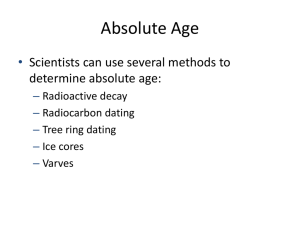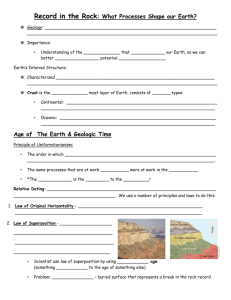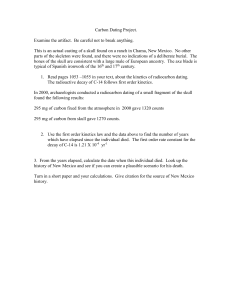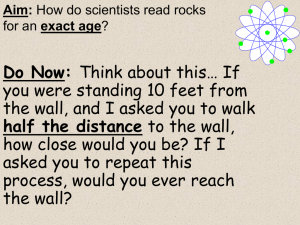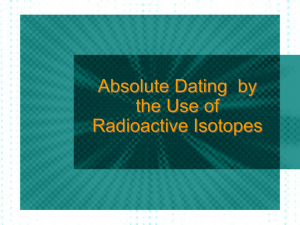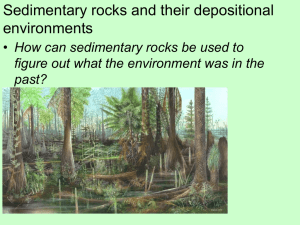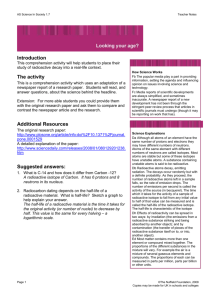21.3 * Absolute
advertisement
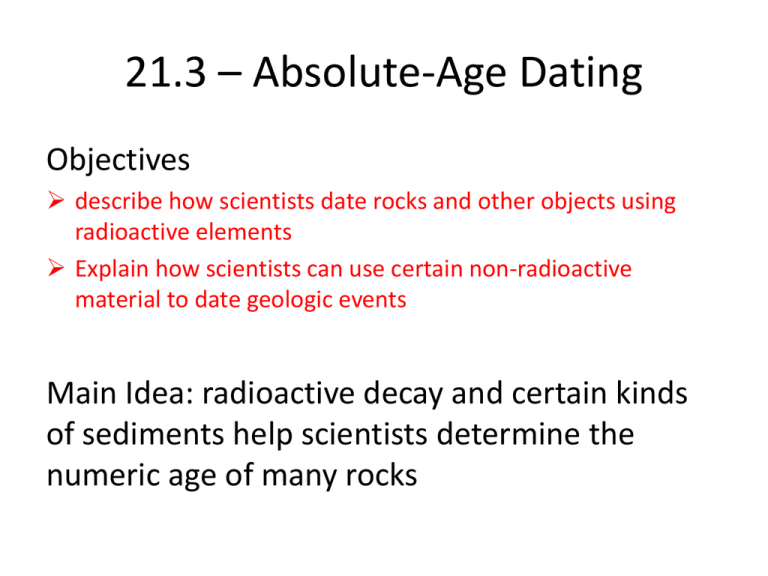
21.3 – Absolute-Age Dating Objectives describe how scientists date rocks and other objects using radioactive elements Explain how scientists can use certain non-radioactive material to date geologic events Main Idea: radioactive decay and certain kinds of sediments help scientists determine the numeric age of many rocks Radioactive Isotopes Measure the decay of the radioactive isotopes in igneous and metamorphic rocks Radioactive Decay Radioactive isotopes emit nuclear particles at a constant rate Identity of an element is due to the number of protons is has Radioactive decay is constant: • Regardless of pressure, temperature, or any other physical changes • Allows scientists to determine absolute age of object in which radioactive element occurs Radiometric Dating The ratio of parent isotope to daughter product indicates the amount of time that has passed since the object formed • When scientists date an object using radioactive isotopes, they are using a method called radiometric dating Half-life and dating rocks Half-life: length of time it takes for one-half of the original isotope to decay After one half-life, 50% of the parent remains, resulting in a 1:1 ratio of parent-to –daughter product. What would happen after 2 half-lives? Dating Rocks to date using radiometric dating, scientists examine the parent-daughter ratios of the radioactive isotopes in the minerals within the rocks • Scientists might use U235, which has a half-life of 700 million yrs, to date a rock that is a few tens of millions of years old • If you wanted to date a rock that is hundreds of millions of years old, scientists might use U-238 due to its longer half-life • Might not work well if you use an element with a short half life to date ancient rocks…why? Radiocarbon Dating Radioactive parent isotope Approximate Half Life Potassium-40 (K-40) 1.3 billion years Uranium-238 (U-238) 4.5 billion years Uranium-235 (U-235) 700 million years Carbon-14 (C-14) 5730 years Scientists use C-14 to determine the age of organic materials, which contain abundant carbon, in a process known as radiocarbon dating Radiocarbon Dating Tissues of all living organisms contain small amounts of C-14 and large amount of C-12 (most abundant form of carbon) Throughout life, C-14 decays but is continually replenished through respiration Therefore, when organism dies, it no longer takes in C-14, so over time, the ratio of C-14 to C-12 decreases Measuring the amount of C-14 can help determine how much time has passed since death Other ways to determine absolute age Tree rings Many trees contain a record of time in the rings of their trunks (annual tree rings) Each annual tree ring consists of a pair of early season and late season growth rings Science of using tree rings to determine absolute age is called dendrochronology • helps confirm the results from radiocarbon dating Matching tree rings from different wood samples Ice Cores Analogous to tree rings Like tree rings, they contain a record of past environmental conditions in annual layers of snow deposition Summer ice tends to have more bubbles and larger crystals than winter ice
